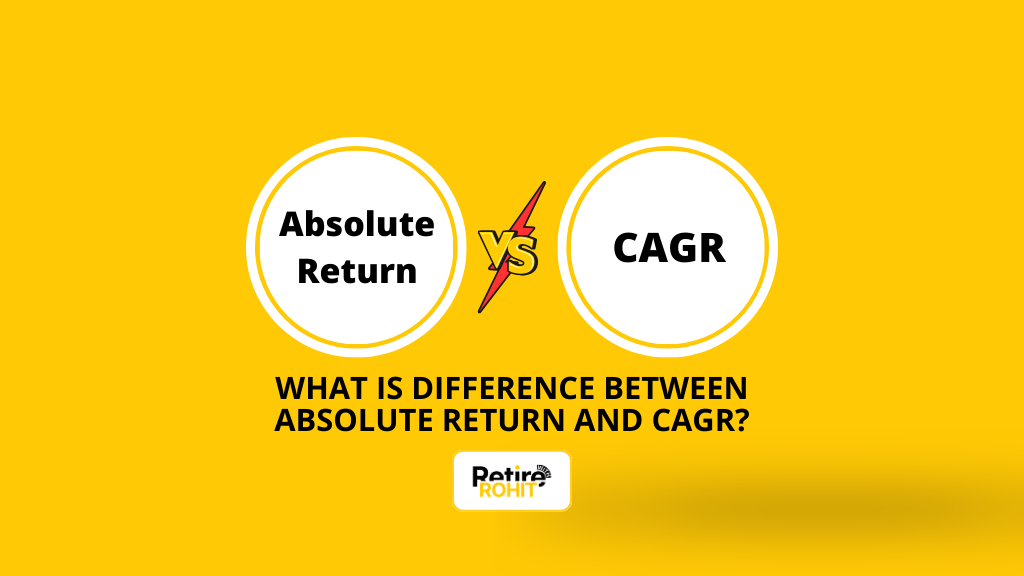What is the Difference Between Absolute Return and CAGR?

If you're new to investing or just trying to understand your mutual fund or stock portfolio better, you’ve probably heard terms like Absolute Return and CAGR. But what do they actually mean? So here we will understand what is the difference between Absolute Return and CAGR.
What is Absolute Return?
Absolute Return is the total return you made on an investment. That’s it. It doesn’t care whether it took 6 months or 6 years, it just tells you how much profit (or loss) you made overall.
Formula
Absolute return calculation is done with the help of the given formula :
"Absolute returns = [(Current Value - Initial Investment Value) / Initial Investment Value] * 100"
For example, you bought shares of Zomato at ₹90 and sold them at ₹120 after 3 months.
Now, for the absolute return calculation, use the above formula :
- Absolute return = [(120 -90) / 90] * 100
- Therefore, Absolute return = 33.33%
Why Absolute Return Matters:
- Easy to calculate: Just the beginning and ending value.
- Useful for short-term trades: Like buying and selling stocks or mutual funds in a few months.
- Independent of time and market: It shows what you gained without worrying about the number of years or benchmarks.
Pros and Cons of Absolute Return
Pros of Absolute Return:
- Very simple to calculate.
- Great for short-term trades.
- No need to know the time or benchmark.
Cons of Absolute Return:
- Doesn’t show how long it took.
- It can be misleading for long-term investments.
Also Check - What is Direct and Indirect Tax?
What is CAGR?
Now, imagine your investment grew steadily every year like a mango tree growing taller year by year. That’s what CAGR tells you: Your average yearly growth rate over a period. It smoothens out all the ups and downs and gives you one clean number.
e.g., Tata Motors Ltd has delivered good profit growth of 93.1% CAGR over the last 5 years.
Formula
The formula to calculate CAGR is :
CAGR = [(Ending Value/Beginning Value)^(1/No. of years)]-1
For example, let's say Rahul invests in a stock of Rs. 1,00,000 for 6 years. And it becomes 3 lakhs after the investment.
Hence , CAGR = (3,00,000/1,00,000)^⅙ - 1
CAGR = 20%
So, Rahul’s money grew by 20% every year on average.
Why CAGR Matters:
- Shows how fast your money grows yearly.
- Best for long-term investments like SIPs, stocks, and real estate.
- Useful for comparing options like FD, PPF, and mutual funds.
Pros and Cons of CAGR
Pros of CAGR:
- Tells the average yearly growth
- Best for long-term investing
- Easy to compare performance
Cons of CAGR:
- Slightly harder to calculate
- Doesn’t show market ups and downs
CAGR VS Absolute Return
The difference between CAGR and absolute return is as follows :
| Feature | CAGR | Absolute Return |
| Meaning | Shows the average yearly growth over a time period. | Shows total gain or loss without considering time. |
| Time Consideration | Considers time; return is annualized. | Time is not considered; only beginning and end values matter. |
| Formula | CAGR = [(Ending Value/Beginning Value)^(1/No. of years)]-1 | Absolute returns = [(Current Value - Initial Investment Value) / Initial Investment Value] * 100 |
| Accuracy | More accurate for long-term performance | Less accurate for comparing long-term investments |
| Benchmark Comparison | Often compared with an index like the Nifty or the Sensex | Usually not compared to any benchmark |
Conclusion
Now you know the difference between Absolute Return and CAGR: Absolute Return shows total return, fast and easy. And CAGR shows how fast you earned it over time, more accurate for the long term. Use the right one depending on your investment duration. Don’t get fooled by fancy numbers without knowing how they were calculated.


